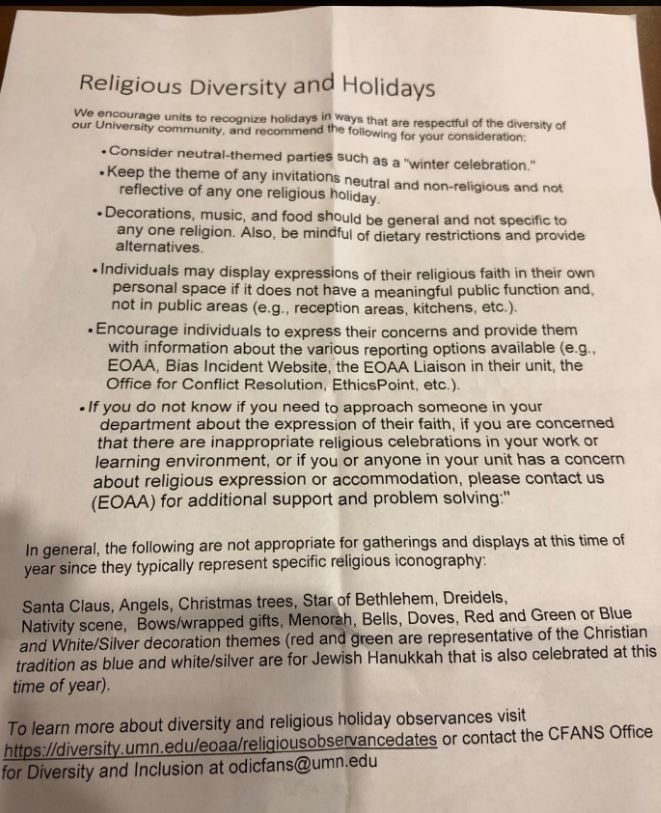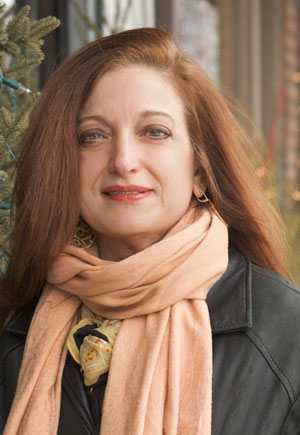
Since the memo created a minor furor and made Gopher Nation something of a national laughing-stock the memo was later described as simply an advisory with no particular authority by the same office that had issued it. Media coverage of events such as this seldom identify the bureaucrats involved. We think that interested folks should be able to know if the person at the next table at McDonalds or across the aisle on a flight to San Antonio was a figure in a matter of interest. Below are some of the people that occupy positions in the large and complex diversity division of the U of M.

Michael Goh and Peter Demerath, leaders of the University Office for Equity and Diversity, and the Generation Next/UROC Faculty Fellows.

Susan Thurston Hamerski, spokesperson for the the school’s College of Food, Agricultural, and Natural Resources Sciences (CFANS), tasked with denying that the grinch memo was a university mandate and was instead an "ill-advised" effort by an undisclosed employee.
Office for Equity and Diversity (OED) Administration
432 Morrill Hall100 Church Street SE
Minneapolis, MN 55455
Phone: 612-624-0594
Fax: 612-626-0397
oed@umn.edu
Michael Goh
Interim Vice President
612-624-0594
mgoh@umn.edu
| Shakeer Abdullah Assistant Vice President 612-624-5124 sabdulla@umn.edu |
Ralph Blanco Administrative Associate 612-625-8680 rblanco@umn.edu |
Jonathan Brown CORE Director 612-626-5462 jonbrown@umn.edu |
| Barbara Chapin Administrator 612-626-7386 chapi001@umn.edu |
Anitra Cottledge Director of Communications 612-625-5445 cottlead@umn.edu |
Denise Dieffenbach Assistant to the Vice President 612-626-9836 ddieffen@umn.edu |
| Sean Garrick Interim Assistant Vice Provost 612-625-5059 sgarrick@umn.edu |
Anne Hornickel Program Director North Star STEM Alliance 612-626-0043 ahornick@umn.edu |
Amelie Hyams Program & Communications Manager 612-626-9178 hyams003@umn.edu |
| Stef Jarvi Director of Education 612-625-9973 swilench@umn.edu |
Wendy Weimerskirch Plager Education Program Manager 612-626-7387 wweimerp@umn.edu |
Julie Showers Interim Associate Vice President 612-624-0594 showers@umn.edu |
| Virajita Singh Assistant Vice Provost 612-625-0498 singh023@umn.edu |
Kitt Young-Dickerson Principal Office and Administrative Specialist 612-625-2961 young959@umn.edu |
|
OED Offices
| Business & Community Economic Development Darryl Peal, director 2221 University Avenue SE, Suite 136 Minneapolis, MN 55414 612-624-0530 bced@umn.edu |
Conflict Resolution Bruce Grosland, interim director 662 Heller Hall (West Bank) 271 19th Avenue South Minneapolis, MN 55455 612-624-1030 ocr@umn.edu |
Disability Resource Center Donna Johnson, director 180 McNamara Alumni Center 200 Oak Street SE Minneapolis, MN 55455 612-626-1333 (V/TTY) ds@umn.edu |
| Equal Opportunity and Affirmative Action Tina Marisam, director 274 McNamara Alumni Center 200 Oak Street SE Minneapolis, MN 55455 612-624-9547 eoaa@umn.edu |
Gender and Sexuality Center for Queer and Trans Life Stef Jarvi (formerly Wilenchek), director 46 Appleby Hall 128 Pleasant St SE Minneapolis, MN 55455 612-625-0537 gsc@umn.edu |
Institute for Diversity, Equity and Advocacy 432 Morrill Hall 100 Church Street SE Minneapolis, MN 55455 612-625-7439 oedidea@umn.edu |
| Multicultural Center for Academic Excellence Aurelio Curbelo, director 140 Appleby Hall 128 Pleasant St SE Minneapolis, MN 55455 612-624-6386 mcae@umn.edu |
Women’s Center 64 Appleby Hall Uyenthi Tran Myhre, acting director 128 Pleasant St SE Minneapolis, MN 55455 612-625-9837 women@umn.edu |
Upper level administrators in the University of Minnesota diversity directorate.
After Christmas a spokesman for the University made an attempt to defuse the situation, per this article in the local press.

University of Minnesota Public Relations Director Evan Lepiska, currently the spokesman in the school's attempt to regain some credibility.

 New York City policemen or storm troopers from a dystopian future? You decide.
New York City policemen or storm troopers from a dystopian future? You decide.